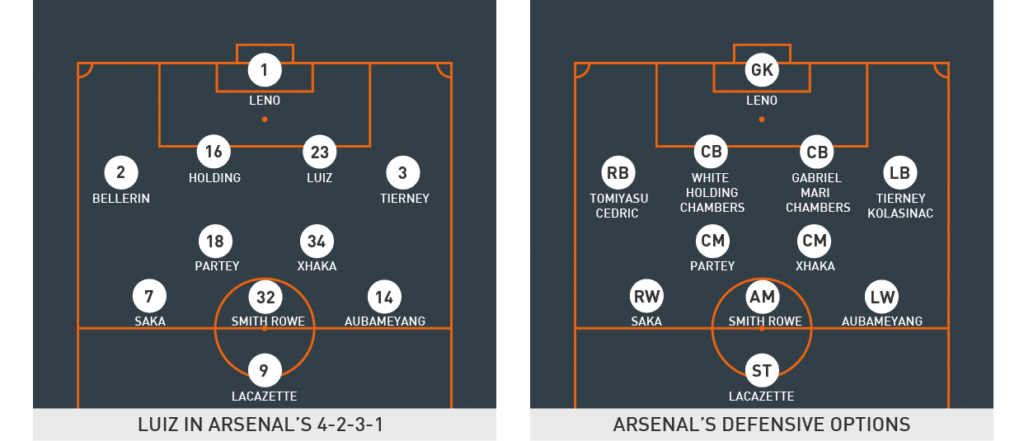
david luiz
Flamengo, 2021–
Profile
It was former Arsenal manager Unai Emery who oversaw David Luiz's £8m transfer from Chelsea in August 2019, and Emery's successor Mikel Arteta who oversaw his departure two years later at the age of 34. Chelsea had first bought Luiz from Benfica in January 2011; it was in Paris that he then worked with Emery, after he had already eliminated Chelsea from the Champions League in March 2015 by scoring the header that gave them the lead in their round-of-16 fixture.
Having returned to the Premier League with Chelsea and then moved on to Arsenal, the Brazilian is again back home, with Flamengo, where he arrived as a free agent, and where he will compete in Brazilian Série A. "It's not just an ability, a quality or determination," said Arteta. "I've really enjoyed learning from him. He's been very helpful every time with the team."
Tactical analysis
Luiz reads play intelligently, and is therefore effective at judging when an opponent will make their final contact with the ball and at blocking attempts at goal. He effectively and discreetly leaves his position to close possession down unless, against quicker and more direct opponents who prefer dribbling, he moves with them and matches their running pattern to delay them but close off their angles towards goal. By doing so Luiz helps his teammates to more easily recover into an organised defensive block.
He uses his body well – particularly against opponents of a similar size – but directly tackles them with less regularity. He instead uses his arms and upper body to move into the attacker’s running path before stretching his legs across that attacker as a player would when attempting to shield possession. More traditional, assertive, standing tackles are largely reserved for when recovering a position during a moment of transition, or when desperately defending close to goal.

Defending in that manner allows Luiz to instead regain possession and then retain it, creating more moments of transition instead of sending the ball into neutral territory and potentially contributing to a further spell off the ball. Importantly, he excels with the ball at his feet. His passing ability is among the finest of any active defender, and perhaps even the very finest over longer distances (above).
The accuracy and angles of his deliveries (below) as the left-sided central defender can both overcome pressure and find forward runners. His ability with both feet enables him to detect and then deliver the pass required for either an inside forward or one playing with greater width.

His expressive nature can regardless contribute to him becoming exposed when playing as one of two central defenders – particularly when required to mark an opponent while juggling other defensive screens, and even more so if that opponent is moving towards his blindside. When there is further space that requires covering, and fewer teammates free and sufficiently compact to support him, he can become more vulnerable.
It is when playing as one of three central defenders that he is more effective. He is then able to prioritise one opponent or area, instead of risking becoming isolated against a predatory attacker. His occasionally inconsistent judgement over when to attempt a tackle is also less of a concern within a back three or five.

Role at Arsenal
Luiz’s ability to secure loose balls and take control when defending against counters helped Arsenal’s midfield to gain more possession. Instead of simply clearing, he often worked a contested ball towards a teammate (above) to turn the act of defending into possession, encouraging his teammates to remain in more advanced territory and to avoid adopting a deeper defensive block. He also offered an element of composure and control in an area where so many teammates had often struggled to do the same. When he did so, further forwards his teammates could advance into spaces and attacking areas.
It was his tackling, and his judgement of when to engage an attacker, that occasionally undermined him at Arsenal. Luiz’s enthusiasm, and the aggressive pressure he often attempted to apply to opponents, was exploited by teams that remained patient in possession and waited for him to overcommit (below).

Arteta has so far mostly remained committed to a back four, from where Luiz’s switches of play from the left inside channel helped penetrate beyond opponents’ defensive structures. Under the Spaniard, Luiz was encouraged to play more passes – where he averaged 51 per game when managed by Emery, with Arteta that figure at one point rose to 73.
Emery’s defensive midfielders were previously given responsibility for progressing beyond the lines in an opponent's structure; Luiz was increasingly doing so instead, and that ability to work possession effectively from defence into what had the potential to be a fine attack could have become influential. Those likeliest to operate as Arsenal’s deep-lying central midfielders simply did not consistently offer the same passing range.



